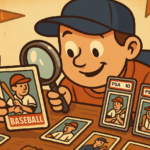Remember when we used to flip through our baseball card collections as kids? I can vividly recall being careful with how I stored all my cards. But not because I was concerned with what they would cost one day in the distant future — it was just something I wanted to do! But as it turns out, your childhood treasures that could be stored away and almost forgotten about these days could actually be worth serious money now.
I’ll go through some key features that could help make an ordinary baseball card an extraordinary find.
Explore MLB Daily Dingers: The Longest Home Runs of the 2025 Season (… So Far)
From Tobacco Stiffeners to Million-Dollar Collectibles
As Jeffrey May and Joseph McMahon of as.com recently pointed out, baseball cards have evolved dramatically from their humble origins. What began as simple stiffeners for tobacco packs, later sold with taffy or bubble gum, quickly became cherished items that children collected and traded. The trading card concept proved so successful that sports worldwide adopted it within two decades.
But here’s the interesting transformation: what was once a children’s pastime has now become serious business. Those flimsy cardboard treasures that kids once stored with rubber bands are now treated as valuable investments.
The Baseball Card Golden Era
The baseball card industry has a rich history. May and McMahon noted the prime period for baseball cards stretched from the 1920s to the 1970s. That’s when billions were distributed each year in bubble gum packs to kids all over the world.
However, the 1980s marked a turning point. Legal challenges and anti-trust legislation opened up the market, but this shift actually began the decline of baseball cards’ cultural significance. The focus turned heavily toward monetary value, with companies purposefully creating scarcity to drive prices up.
Record-Breaking Baseball Card Values
Just how valuable can these cardboard treasures become? The numbers are truly staggering. According to May and McMahon, the most valuable baseball card ever sold is the 1952 Topps Mickey Mantle, which fetched an incredible $12.6 million. Following behind are the 1909 T206 Honus Wagner at $7.25 million and the 1914 Baltimore News Babe Ruth at $6 million.
The fact that multiple cards have sold for over a million dollars demonstrates the extraordinary potential value in this market. These aren’t just collectibles—they’re significant financial assets.
What Makes a Baseball Card Worth Millions?
So what exactly makes certain cards command such astronomical prices? Collectors and appraisers look for these five key characteristics:
- Player Significance – Cards featuring legendary players like Babe Ruth, Mickey Mantle, and Honus Wagner consistently command the highest prices.
- Condition – Mint condition cards (ones without creases, fading, or wear) are much more valuable than damaged ones. Professional grading services rate cards on a scale from 1-10, with pristine examples receiving the “Gem Mint 10” designation.
- Rarity – Limited production runs, cards withdrawn from circulation, or those that survived in small numbers are inherently more valuable.
- Error Cards – Cards with printing mistakes or variations that were quickly corrected can become highly sought after by serious collectors.
- Historical Significance – Rookie cards of Hall of Famers or cards associated with significant milestones often command premium prices.
The Collector’s Dilemma
There’s something bittersweet about the transformation of baseball cards from cherished childhood possessions to investment vehicles. After all, there are so many stories and emotional attachments that can come with specific cards. May and McMahon note that baseball fans who grew up with these cards might’ve sacrificed some value/profits by not keeping them in top condition.
What are your most prized possessions when it comes to baseball cards? Why? Let me know in the comments.
Love home runs? Sign up for my Substack today and start getting interesting home run-related observations straight to your inbox three times per week!





Leave a Reply